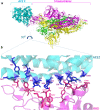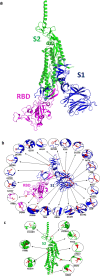Emerging SARS-CoV-2 Variants: Genetic Variability and Clinical Implications
- PMID: 34905108
- PMCID: PMC8669229
- DOI: 10.1007/s00284-021-02724-1
Emerging SARS-CoV-2 Variants: Genetic Variability and Clinical Implications
Abstract
The sudden rise in COVID-19 cases in 2020 and the incessant emergence of fast-spreading variants have created an alarming situation worldwide. Besides the continuous advancements in the design and development of vaccines to combat this deadly pandemic, new variants are frequently reported, possessing mutations that rapidly outcompeted an existing population of circulating variants. As concerns grow about the effects of mutations on the efficacy of vaccines, increased transmissibility, immune escape, and diagnostic failures are few other apprehensions liable for more deadly waves of COVID-19. Although the phenomenon of antigenic drift in new variants of SARS-CoV-2 is still not validated, it is conceived that the virus is acquiring new mutations as a fitness advantage for rapid transmission or to overcome immunological resistance of the host cell. Considerable evolution of SARS-CoV-2 has been observed since its first appearance in 2019, and despite the progress in sequencing efforts to characterize the mutations, their impacts in many variants have not been analyzed. The present article provides a substantial review of literature explaining the emerging variants of SARS-CoV-2 circulating globally, key mutations in viral genome, and the possible impacts of these new mutations on prevention and therapeutic strategies currently administered to combat this pandemic. Rising infections, mortalities, and hospitalizations can possibly be tackled through mass vaccination, social distancing, better management of available healthcare infrastructure, and by prioritizing genome sequencing for better serosurveillance studies and community tracking.
© 2021. The Author(s), under exclusive licence to Springer Science+Business Media, LLC, part of Springer Nature.
Conflict of interest statement
The authors declare no conflict of interest.
Figures





Similar articles
-
Comprehensive characterization of the antibody responses to SARS-CoV-2 Spike protein finds additional vaccine-induced epitopes beyond those for mild infection.Elife. 2022 Jan 24;11:e73490. doi: 10.7554/eLife.73490. Elife. 2022. PMID: 35072628 Free PMC article.
-
SARS-CoV-2 variants and COVID-19 vaccines: Current challenges and future strategies.Int Rev Immunol. 2023;42(6):393-414. doi: 10.1080/08830185.2022.2079642. Epub 2022 May 28. Int Rev Immunol. 2023. PMID: 35635216 Review.
-
The British variant of the new coronavirus-19 (Sars-Cov-2) should not create a vaccine problem.J Biol Regul Homeost Agents. 2021 Jan-Feb;35(1):1-4. doi: 10.23812/21-3-E. J Biol Regul Homeost Agents. 2021. PMID: 33377359
-
Emergence of novel SARS-CoV-2 variants in the Netherlands.Sci Rep. 2021 Mar 23;11(1):6625. doi: 10.1038/s41598-021-85363-7. Sci Rep. 2021. PMID: 33758205 Free PMC article.
-
Mutations in SARS-CoV-2: Insights on structure, variants, vaccines, and biomedical interventions.Biomed Pharmacother. 2023 Jan;157:113977. doi: 10.1016/j.biopha.2022.113977. Epub 2022 Nov 7. Biomed Pharmacother. 2023. PMID: 36370519 Free PMC article. Review.
Cited by
-
Effectiveness of mRNA COVID-19 Vaccination on SARS-CoV-2 Infection and COVID-19 in Sicily over an Eight-Month Period.Vaccines (Basel). 2022 Mar 11;10(3):426. doi: 10.3390/vaccines10030426. Vaccines (Basel). 2022. PMID: 35335058 Free PMC article.
-
Potential linear B-cells epitope change to a helix structure in the spike of Omicron 21L or BA.2 predicts increased SARS-CoV-2 antibodies evasion.Virology. 2022 Aug;573:84-95. doi: 10.1016/j.virol.2022.06.010. Epub 2022 Jun 16. Virology. 2022. PMID: 35732100 Free PMC article.
-
Dynamics of Viral Infection and Evolution of SARS-CoV-2 Variants in the Calabria Area of Southern Italy.Front Microbiol. 2022 Jul 28;13:934993. doi: 10.3389/fmicb.2022.934993. eCollection 2022. Front Microbiol. 2022. PMID: 35966675 Free PMC article.
-
Review of concerned SARS-CoV-2 variants like Alpha (B.1.1.7), Beta (B.1.351), Gamma (P.1), Delta (B.1.617.2), and Omicron (B.1.1.529), as well as novel methods for reducing and inactivating SARS-CoV-2 mutants in wastewater treatment facilities.J Hazard Mater Adv. 2022 Aug;7:100140. doi: 10.1016/j.hazadv.2022.100140. Epub 2022 Aug 4. J Hazard Mater Adv. 2022. PMID: 37520798 Free PMC article. Review.
-
Individual genetic variability mainly of Proinflammatory cytokines, cytokine receptors, and toll-like receptors dictates pathophysiology of COVID-19 disease.J Med Virol. 2022 Sep;94(9):4088-4096. doi: 10.1002/jmv.27849. Epub 2022 May 31. J Med Virol. 2022. PMID: 35538614 Free PMC article. Review.
References
-
- Home—Johns Hopkins Coronavirus Resource Center. https://coronavirus.jhu.edu/. Accessed 2 June 2021
Publication types
MeSH terms
Supplementary concepts
Grants and funding
- Intensification of Research in High Priority Area (IRHPA) (Project no. IPA/2020/000054)/science and engineering research board, department of science and technology (dst-serb)
- Intensification of Research in High Priority Area (IRHPA) (Project no. IPA/2020/000054)/science and engineering research board, department of science and technology (dst-serb)
LinkOut - more resources
Full Text Sources
Medical
Research Materials
Miscellaneous

